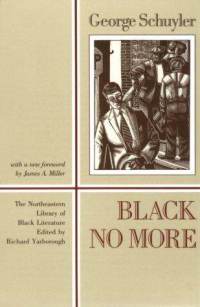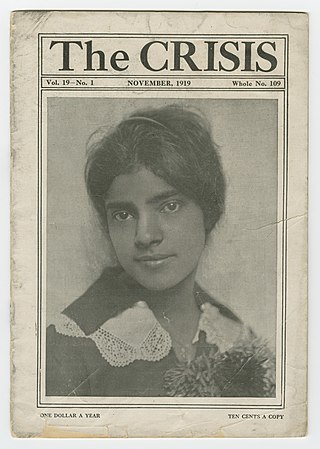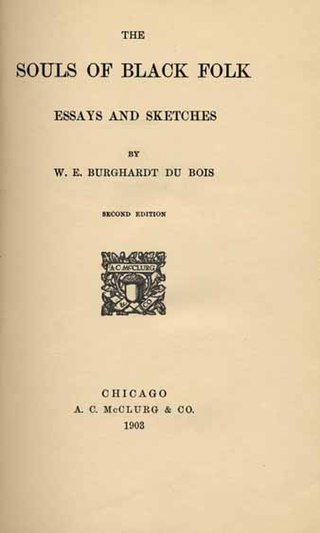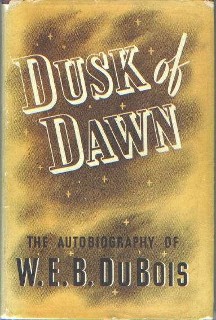Related Research Articles
Racism is discrimination and prejudice against people based on their race or ethnicity. Racism can be present in social actions, practices, or political systems that support the expression of prejudice or aversion in discriminatory practices. The ideology underlying racist practices often assumes that humans can be subdivided into distinct groups that are different in their social behavior and innate capacities and that can be ranked as inferior or superior. Racist ideology can become manifest in many aspects of social life. Associated social actions may include nativism, xenophobia, otherness, segregation, hierarchical ranking, supremacism, and related social phenomena.

Booker Taliaferro Washington was an American educator, author, orator, and adviser to several presidents of the United States. Between 1890 and 1915, Washington was the dominant leader in the African-American community and of the contemporary Black elite. Washington was from the last generation of black American leaders born into slavery and became the leading voice of the former slaves and their descendants. They were newly oppressed in the South by disenfranchisement and the Jim Crow discriminatory laws enacted in the post-Reconstruction Southern states in the late 19th and early 20th centuries.

William Edward Burghardt Du Bois was an American sociologist, socialist, historian, and Pan-Africanist civil rights activist. Born in Great Barrington, Massachusetts, Du Bois grew up in a relatively tolerant and integrated community. After completing graduate work at the Friedrich Wilhelm University and Harvard University, where he was the first African American to earn a doctorate, he became a professor of history, sociology, and economics at Atlanta University. Du Bois was one of the founders of the National Association for the Advancement of Colored People (NAACP) in 1909.

Black No More: Being an Account of the Strange and Wonderful Workings of Science in the Land of the Free, A.D. 1933-1940 is a 1931 Harlem Renaissance satire on American race relations by George S. Schuyler. In the novel, Schuyler targets both the Ku Klux Klan and NAACP in condemning the ways in which race functions as both an obsession and a commodity in early twentieth-century America. The central premise of the novel is that an African American scientist invents a process that can transform Black people into white people. Those who have internalized white racism, those who are tired of inferior opportunities socially and economically, and those who simply want to expand their sexual horizons, undergo the procedure. As the country "whitens", the economic importance of racial segregation in the South as a means of maintaining elite white economic and social status becomes increasingly apparent, as the South relies on Black labor through sharecropping.
Scientific racism, sometimes termed biological racism, is the pseudoscientific belief that the human species can be subdivided into biologically distinct taxa called "races," and that empirical evidence exists to support or justify racism, racial inferiority, or racial superiority. Before the mid-20th century, scientific racism was accepted throughout the scientific community, but it is no longer considered scientific. The division of humankind into biologically separate groups, along with the assignment of particular physical and mental characteristics to these groups through constructing and applying corresponding explanatory models, is referred to as racialism, race realism, or race science by those who support these ideas. Modern scientific consensus rejects this view as being irreconcilable with modern genetic research.

Countee Cullen was an American poet, novelist, children's writer, and playwright, particularly well known during the Harlem Renaissance.

The Crisis is the official magazine of the National Association for the Advancement of Colored People (NAACP). It was founded in 1910 by W. E. B. Du Bois (editor), Oswald Garrison Villard, J. Max Barber, Charles Edward Russell, Kelly Miller, William Stanley Braithwaite, and Mary Dunlop Maclean. The Crisis has been in continuous print since 1910, and it is the oldest Black-oriented magazine in the world. Today, The Crisis is "a quarterly journal of civil rights, history, politics and culture and seeks to educate and challenge its readers about issues that continue to plague African Americans and other communities of color."
African American literature is the body of literature produced in the United States by writers of African descent. It begins with the works of such late 18th-century writers as Phillis Wheatley. Before the high point of enslaved people narratives, African American literature was dominated by autobiographical spiritual narratives. The genre known as slave narratives in the 19th century were accounts by people who had generally escaped from slavery, about their journeys to freedom and ways they claimed their lives. The Harlem Renaissance of the 1920s was a great period of flowering in literature and the arts, influenced both by writers who came North in the Great Migration and those who were immigrants from Jamaica and other Caribbean islands. African American writers have been recognized by the highest awards, including the Nobel Prize given to Toni Morrison in 1993. Among the themes and issues explored in this literature are the role of African Americans within the larger American society, African American culture, racism, slavery, and social equality. African-American writing has tended to incorporate oral forms, such as spirituals, sermons, gospel music, blues, or rap.

The Souls of Black Folk: Essays and Sketches is a 1903 work of American literature by W. E. B. Du Bois. It is a seminal work in the history of sociology and a cornerstone of African-American literature.
Double consciousness is the dual self-perception experienced by subordinated or colonized groups in an oppressive society. The term and the idea were first published in W. E. B. Du Bois's autoethnographic work, The Souls of Black Folk in 1903, in which he described the African American experience of double consciousness, including his own.
The talented tenth is a term that designated a leadership class of African Americans in the early 20th century. Although the term was created by white Northern philanthropists, it is primarily associated with W. E. B. Du Bois, who used it as title of an influential essay, published in 1903. It appeared in The Negro Problem, a collection of essays written by leading African Americans and assembled by Booker T. Washington.
The term color line was originally used as a reference to the racial segregation that existed in the United States after the abolition of slavery. An article by Frederick Douglass that was titled "The Color Line" was published in the North American Review in 1881. The phrase gained fame after W. E. B. Du Bois' repeated use of it in his 1903 book The Souls of Black Folk.
In the English language, the word negro is a term historically used to denote persons considered to be of Black African heritage. The word negro means the color black in both Spanish and in Portuguese, where English took it from. The term can be construed as offensive, inoffensive, or completely neutral, largely depending on the region or country where it is used, as well as the context in which it is applied. It has various equivalents in other languages of Europe.

Maud Cuney Hare was an American pianist, musicologist, writer, and African-American activist in Boston, Massachusetts in the United States. She was born in Galveston, the daughter of famed civil rights leader Norris Wright Cuney, who led the Texas Republican Party during and after the Reconstruction Era, and his wife Adelina, a schoolteacher. In 1913 Cuney-Hare published a biography of her father.

Postcolonial international relations is a branch of scholarship that approaches the study of international relations (IR) using the critical lens of postcolonialism. This critique of IR theory suggests that mainstream IR scholarship does not adequately address the impacts of colonialism and imperialism on current day world politics. Despite using the language of post-, scholars of Postcolonial IR argue that the legacies of colonialism are ongoing, and that critiquing International Relations with this lens allows scholars to contextualize global events. By bridging postcolonialism and International Relations, scholars point to the process of globalization as a crucial point in both fields, due to the increases in global interactions and integration. Postcolonial IR focuses on the re-narrativization of global politics to create a balanced transnational understanding of colonial histories, and attempts to tie non-Western sources of thought into political praxis.

Dusk of Dawn: An Essay Toward an Autobiography of a Race Concept is a 1940 autobiographical text by W. E. B. Du Bois that examines his life and family history in the context of contemporaneous developments in race relations.
Theodore Lothrop Stoddard was an American historian, journalist, political scientist and white nationalist. Stoddard wrote several books which advocated eugenics, white supremacy and scientific racism, including The Rising Tide of Color Against White World-Supremacy (1920). He advocated a racial hierarchy which he believed needed to be preserved through anti-miscegenation laws. Stoddard's books were once widely read both inside and outside the United States.
Racism has been present in Brazil since its colonial period and is pointed as one of the major and most widespread types of discrimination, if not the most, in the country by several anthropologists, sociologists, jurists, historians and others. The myth of a Racial Democracy, a term originally coined by Brazilian sociologist Gilberto Freyre in his 1933 work Casa-Grande & Senzala, is used by many people in the country to deny or downplay the existence and/or the broad extension of racism in Brazil.

May Howard Jackson was an African American sculptor and artist. Active in the New Negro Movement and prominent in Washington, D.C.'s African American intellectual circle in the period 1910-30, she was known as "one of the first black sculptors to...deliberately use America's racial problems" as the theme of her art. Her dignified portrayals of "mulatto" individuals as well as her own struggles with her multiracial identity continue to call for the interpretation and assessment of her work.
The Negro Problem is a collection of seven essays by prominent Black American writers, such as W. E. B. Du Bois and Paul Laurence Dunbar, edited by Booker T. Washington, and published in 1903. It covers law, education, disenfranchisement, and Black Americans' place in American society.
References
- ↑ Schenbeck, Lawrence (2012). Racial Uplift and American Music, 1878-1943. United States of America: The University Press of Mississippi. pp. 3–5. ISBN 978-1-61703-229-5.
- ↑ Chresfield, M. (2013). "To Improve the Race: Eugenics as a Strategy for Racial Uplift".
{{cite journal}}: Cite journal requires|journal=(help) - ↑ Moore, J.M. (2003). Booker T. Washington, W.E.B. Du Bois, and the struggle for racial uplift. Wilmington, DE: Scholarly Resources.
- ↑ Gaines, Kevin (1991). Uplifting the Race: Black middle-class ideology in the era of the "New Negro" 1890-1935.
- ↑ Barrett, D (2004). "Globalizing social movement theory: The case of eugenics. Theory and Society".
{{cite journal}}: Cite journal requires|journal=(help) - ↑ Du Bois, W. E. B. (William Edward Burghardt), 1868-1963, author. (2019-05-28). The Souls of Black Folk: the Unabridged Classic. ISBN 9781945186646. OCLC 1099525108.
{{cite book}}:|last=has generic name (help)CS1 maint: multiple names: authors list (link) - ↑ Martin, Tony, 1942-2013. (1984). The Pan-African connection : from slavery to Garvey and beyond. 1985 printing (1st Majority Press ed.). Dover, Mass.: Majority Press. ISBN 0912469110. OCLC 10833862.
{{cite book}}: CS1 maint: multiple names: authors list (link) - ↑ Hare, Nathan. (1991). The Black Anglo-Saxons (2nd ed.). Chicago: Third World Press. ISBN 0883781301. OCLC 25043432.
- ↑ Peebles-Wilkins, Wilma (2013-06-11), "Washington, Booker Taliaferro", Encyclopedia of Social Work, NASW Press and Oxford University Press, doi:10.1093/acrefore/9780199975839.013.815, ISBN 9780199975839
- ↑ Du Bois, W. E. B. (William Edward Burghardt), 1868-1963, author. (2019-05-28). The Souls of Black Folk: the Unabridged Classic. ISBN 9781945186646. OCLC 1099525108.
{{cite book}}:|last=has generic name (help)CS1 maint: multiple names: authors list (link) - ↑ "Globalization, Indian Beauty Nationalism, and Colorism", The Global Beauty Industry, Routledge, 2015-09-16, pp. 52–72, doi:10.4324/9781315733432-4, ISBN 9781315733432
- ↑ The Souls of Black Folk. 2017-07-05. doi:10.4324/9781912282593. ISBN 9781912282593.
- ↑ "Blue Vein Society/Paper Bag Test", Encyclopedia of Human Services and Diversity, SAGE Publications, Inc., 2014, doi:10.4135/9781483346663.n68, ISBN 9781452287485
- ↑ Miller, Tara D. (2016-04-28), "The Significant Value of Historically Black Colleges and Universities", Graduate Education at Historically Black Colleges and Universities (HBCUs), Routledge, pp. 113–123, doi:10.4324/9781315648859-10, ISBN 9781315648859, S2CID 159017961
- ↑ Uzogara, Ekeoma E.; Lee, Hedwig; Abdou, Cleopatra M.; Jackson, James S. (2014-04-01). "A comparison of skin tone discrimination among African American men: 1995 and 2003". Psychology of Men & Masculinity. 15 (2): 201–212. doi:10.1037/a0033479. ISSN 1524-9220. PMC 4365794 . PMID 25798076.